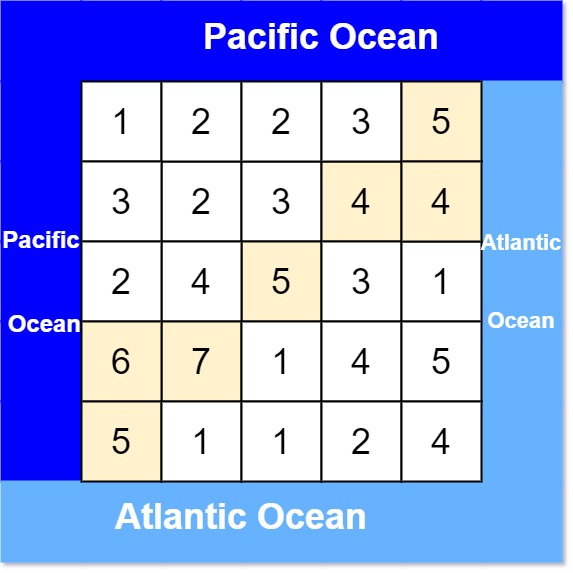Leetcode 417. Pacific Atlantic Water Flow
Explanation for Leetcode 417 - Pacific Atlantic Water Flow, and its solution in Python.
Problem
Leetcode 417 - Pacific Atlantic Water Flow
Example:
1
2
3
4
5
6
7
8
9
10
11
12
13
14
15
16
17
18
19
20
21
22
Input: heights = [[1,2,2,3,5],[3,2,3,4,4],[2,4,5,3,1],[6,7,1,4,5],[5,1,1,2,4]]
Output: [[0,4],[1,3],[1,4],[2,2],[3,0],[3,1],[4,0]]
Explanation: The following cells can flow to the Pacific and Atlantic oceans, as shown below:
[0,4]: [0,4] -> Pacific Ocean
[0,4] -> Atlantic Ocean
[1,3]: [1,3] -> [0,3] -> Pacific Ocean
[1,3] -> [1,4] -> Atlantic Ocean
[1,4]: [1,4] -> [1,3] -> [0,3] -> Pacific Ocean
[1,4] -> Atlantic Ocean
[2,2]: [2,2] -> [1,2] -> [0,2] -> Pacific Ocean
[2,2] -> [2,3] -> [2,4] -> Atlantic Ocean
[3,0]: [3,0] -> Pacific Ocean
[3,0] -> [4,0] -> Atlantic Ocean
[3,1]: [3,1] -> [3,0] -> Pacific Ocean
[3,1] -> [4,1] -> Atlantic Ocean
[4,0]: [4,0] -> Pacific Ocean
[4,0] -> Atlantic Ocean
Note that there are other possible paths for these cells to flow to the Pacific and Atlantic oceans.
Input: heights = [[1]]
Output: [[0,0]]
Explanation: The water can flow from the only cell to the Pacific and Atlantic oceans.
Approach
We can use DFS and using DP to track all the visited nodes and if both pacific and atlantic at its coordination is True, we return its coordinate
Here is the Python code for the solution:
1
2
3
4
5
6
7
8
9
10
11
12
13
14
15
16
17
18
19
20
21
22
23
24
25
26
27
28
29
30
31
32
33
class Solution:
def pacificAtlantic(self, heights: List[List[int]]) -> List[List[int]]:
pacific = [[False] * len(heights[0]) for _ in range(len(heights))]
atlantic = [[False] * len(heights[0]) for _ in range(len(heights))]
def dfs(i, j, visited):
visited[i][j] = True
for dx, dy in [(-1,0), (1,0), (0,-1), (0,1)]:
ni, nj = i+dx, j+dy
if 0 <= ni < len(heights) and 0 <= nj < len(heights[0]) and not visited[ni][nj]:
if heights[ni][nj] >= heights[i][j]:
dfs(ni, nj, visited)
for i in range(len(heights)):
dfs(i, 0, pacific)
for j in range(len(heights[0])):
dfs(0, j, pacific)
for i in range(len(heights)):
dfs(i, len(heights[0])-1, atlantic)
for j in range(len(heights[0])):
dfs(len(heights)-1, j, atlantic)
res = []
for i in range(len(heights)):
for j in range(len(heights[0])):
if pacific[i][j] and atlantic[i][j]:
res.append([i,j])
print(pacific)
print(atlantic)
return res
Time Complexity and Space Complexity
Time Complexity: $O(n*m)$
Space Complexity: $O(n*m)$
This post is licensed under CC BY 4.0 by the author.
